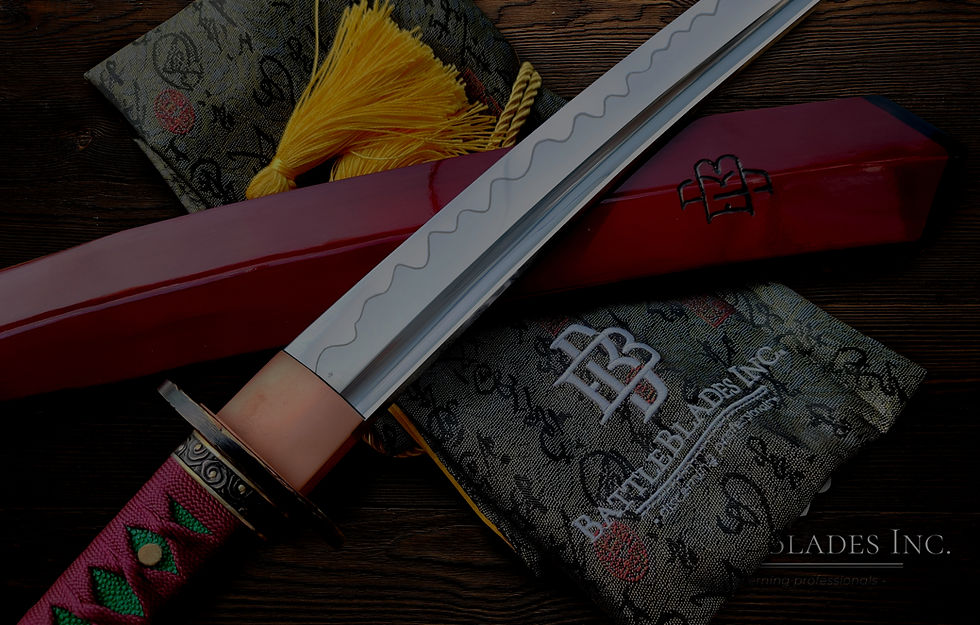

IKAKU KODACHI
MSRP € 929
Developed during the Sengoku period in the 16th century and popularized by the local security force of the influential Kuroda samurai clan, Ikkaku-ryū toritejutsu was a martial art system, that was mainly used for seizing and capturing enemies, as well as other dangerous armed criminals and swordsmen. However, contrary to the more widely-used toritejutsu style, jittejutsu, the Ikkaku-ryū toritejutsu did not focuse only on the use of jitte (blunt truncheon, "the sword breaker"), but also utilized martial art skills and weapons like jujutsu (grappling), tessen (war-fan) and tanbō (short-staff).
Originally the complete Ikkaku-ryū was taught in the Shintō (New Just), but after the political revolution of Meiji-restoration brought the Tokugawa shogunate (military rule) to its end in late 19th century, the two largest surviving branches of the Kuroda-no-jo tradition, Jigyo and Haruyoshi -branches were merged and streamlined into what would become the modern day Shintō (Way Of The Gods). Of the original seizing-arts of the Ikkaku-ryū, only the jutte and tessen arts were incorporated into the new system. This handforged masterpiece is our way to pay homage to the culture of the older original toritejutsu system, and its less recognized weapons.
Meet the Ikaku Kodachi, our widest, most lethal short sword. Designed for close combat, the new, more compact hybrid packs the ultimate cutting power of a longer heavier blade, whilst maintaining the optimal movability and slyness of a shorter sword. The idea was to create a significantly more compact weapon than the standard katana, while still being longer and more efficient than a standard wakizashi. While designing the sword and playing around with of a mix of best of both worlds (katana and wakizashi), the tsuka was calculated to be most optimal at a longer length for this type of a hybrid weapon. The Tsuka is slightly longer than a standard wakizashi's, ensuring maximum efficiency whether wielding the sword with a one- or two-handed grip.
The wider motohaba and nagako compensate for the compactness of the nagasa, adding much more downward power when slashing and chopping compared to any of our previous designs. Because of the heavier nagasa, a wider longer nagako was needed along with a double-sided Bo-Hi, to help perfectly balance and reduce the overall weight of the sword without sacrificing any of its strength or blade integrity. The kissaki is infuenced by the intimidating fukura tsuku shape of our Gokudo Aikuchi. The fukura refers to the curvature or bulbousness of the kissaki’s cutting-edge, which may curve to a greater (kareru tsuku) or lesser degree (fukura tsuku). In this case there is no visible kissaki line. The nagasa is fully handforged and stone-polished by master swordsmiths, quaranteeing a razor sharp cutting edge and highest grade polishing. The absolutely gorgeous clay tempered hamon completes the intimidating look.
Despite the unusually thick nagako, the tsuka stays respecful to its roots, maintaining the elegant and slender traditional Rikko (hourglass) shape. The graceful color scheme was carefully chosen to honor those magnificent swords once made in feudal Japan. The hardwood tsuka is wrapped in emerald green samegawa and completed with silver menuki and a rich royal maroon color silk tsuka-ito. The fuchi, kashira, tsuba the new habaki and seppa plates are made of copper. They are refined to create contrast, as well as highlight the sophisticated color scheme, giving the details the attention they demand. The elegant dragon-flower tsuba brings out the simple, yet stunning, copper habaki.
The saya is truly a work of art. It was meticulously designed to fit the unique aesthethic of the sword. The gorgeous red beaver-tail shaped hardwood saya is slowly and carefully curved to match the sori of the sword. It takes an extremely skilled and experienced craftsman to be able to produce this difficult level of a saya and bring the design to life, especially because of its intricate shape. The saya is dyed red and lacquered several times for maximum shine and protection. The rich red-and-black silk Sageo beautifully highlights the colors of the sword, and wraps the whole design together. The koiguchi and the big kojiri in the end of the saya, are made of genuine buffalo horn, and the hand-carved and painted BattleBlades Inc. logo crowns the whole.
As always, this weapon is guaranteed BattleBlades quality and comes in an embroidered BattleBlades Inc. silk sword bag, along with a serial numbered Certificate of Authenticity.
Order your own handforged Ikaku Kodachi now - check out our dealers here!
Read more about T10 steel and katana parts.
/ BB-IK
SPECIFICATIONS OF IKAKU KODACHI
OVERALL LENGTH
2.46 Shaku / 74.5 cm / 29.33 in
NAGASA
1.75 Shaku / 53.0 cm / 20.87 in
TSUKA
0.69 Shaku / 21.0 cm / 8.27 in
KASANE
0.003 Shaku / 8.0 mm / 0.31 in
SAKIKASANE
0.0013 Shaku / 4.0 mm / 0.16 in
MOTOHABA
0.132 Shaku / 4.0 cm / 1.57 in
SAKIHABA
0.096 Shaku / 2.9 cm / 1.14 in
NAGASA MATERIAL
clay tempered hand forged T10 steel
WEIGHT WITHOUT SAYA
935 g / 2.06 lbs












